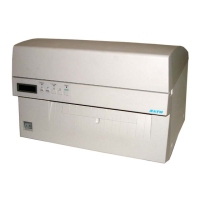SATO M-10e TT/DT Printers Service Manual
PN 9001098
Rev. A
3-2
Section 3. Interface Specifications
Interface Types
The Parallel interface will probably be the most useful in communicating with IBM PCs and
compatibles. The RS232C Serial Interface allows connectivity to a number of other hosts. The
USB Interface allows the printer to be connected to a computer that supports peripherals attached
to a USB bus. Up to 127 peripherals can be connected to a single USB port. The interfaces
available are a high speed (to 57.6k bps) serial interface, an Ethernet interface or an optional
Universal Serial Bus (USB) interface
WARNING: Never connect or disconnect interface cables (or use a switch box) with power
applied to either the host or the printer. This may cause damage to the interface circuitry in the
printer/host and is not covered by warranty.
3.3 The Receive Buffer
The M-10e printer has the ability to receive a data stream from the host in one of two ways. The
receive buffer may be configured to accept one print job at a time or multiple print jobs. The single
job print buffer is generally used by software programs that wish to maintain control of the job
print queue so that it can move a high priority job in front of ones of lesser importance. The multi-
ple job buffer on the other hand prints all jobs in the order they are received by the printer and the
order of printing cannot be changed.
Single Job Buffer
The printer receives and prints one job at a time. Each job must not exceed 2.95MB.
Multi Job Buffer
The printer is able to continuously receive print jobs, compiling and printing other jobs at the same
time. It acts much like a “print buffer” to maximize the performance of the host and the
printer.When using the RS232 Serial Interface, the Multi Job Buffer uses either the Ready/Busy
with DTR (pin 20) or X-On/X-Off flow control protocols. See those sections for more details.
With an empty receiving buffer, the status of DTR is “high” (or an X-On status if using X-On/X-
Off) meaning the printer is ready to receive data. When the receive buffer is holding 2.0MB of
data (1MB from being full), DTR will go “low” (or an X-Off is sent) indicating the printer can no
longer receive data. This condition is called “Buffer Near Full”.
AVAILABLE INTERFACES
CENTRONICS
PARALLEL
INTERFACE
RS232C SERIAL
INTERFACE
USB INTERFACE
ETHERNET
INTERFACE

